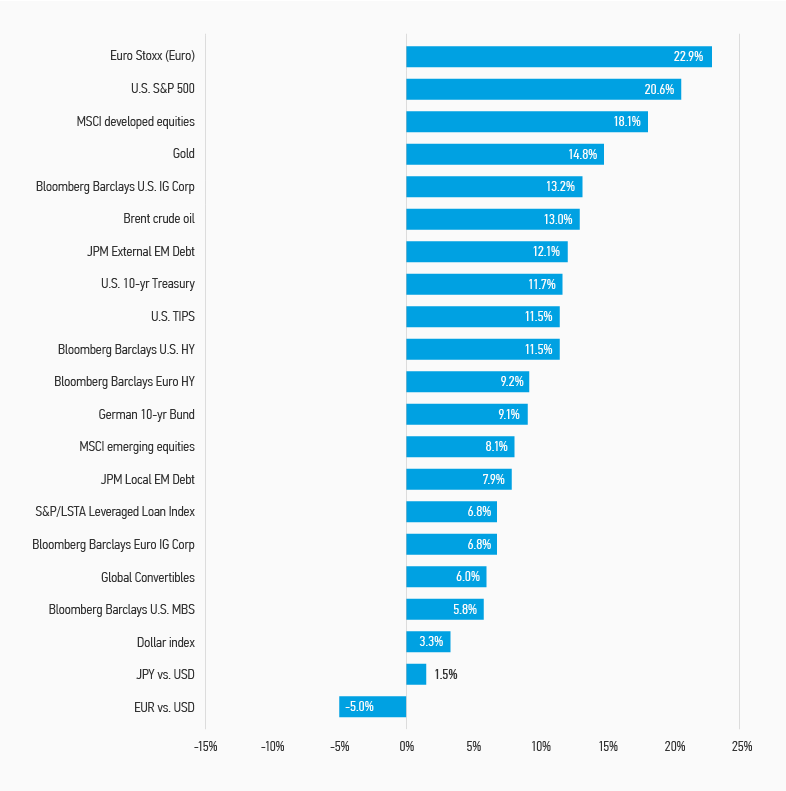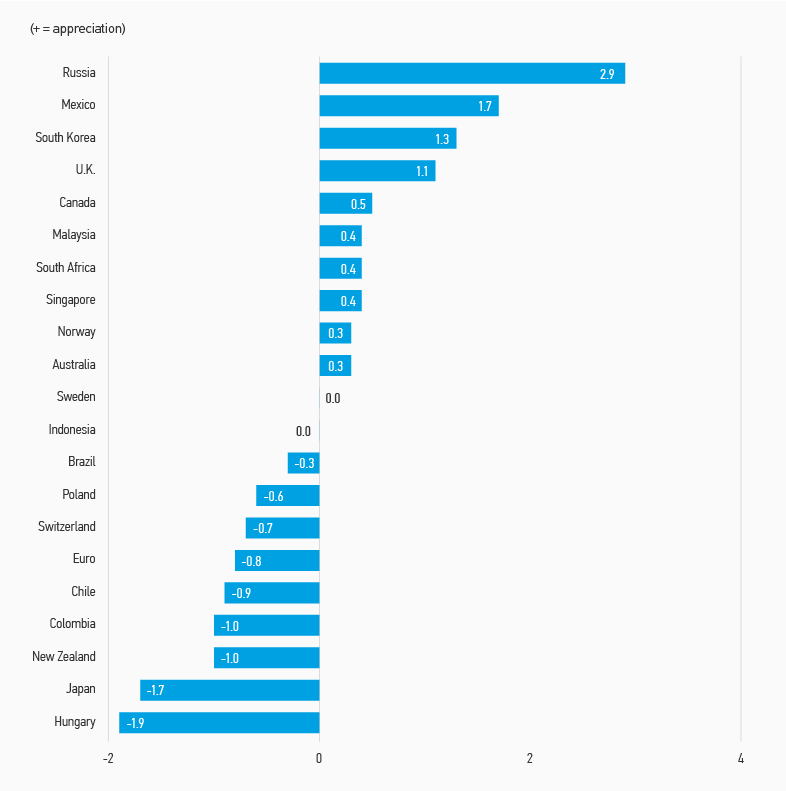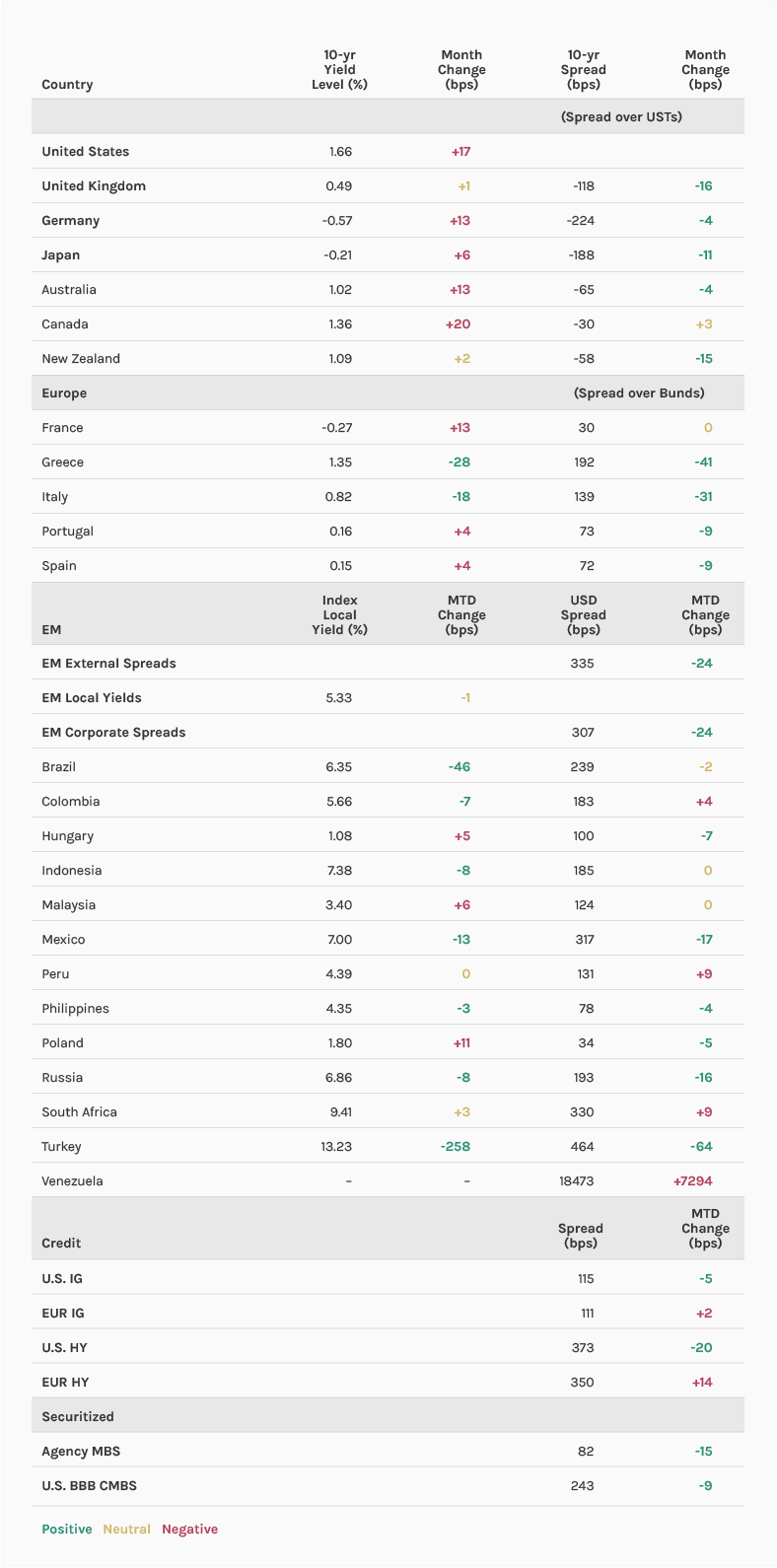
Morgan Stanley: Reversal Month
A bit of optimism and sticker shock arrived in September. After exceptional performance in August, September proved much more challenging as news flow turned less dire (although not necessarily positive) and government bonds were no longer so attractive.
06.11.2019 | 12:33 Uhr
The eagerly awaited European Central Bank (ECB) and Federal Reserve (Fed) meetings finally arrived. While in no ways hawkish, they did disappoint elevated expectations (the ECB by cutting rates by only 10 basis points [bps], and the Fed with its guidance on future possible rate cuts). While their commentary did not preclude further policy accommodation, in both cases there was a distinct element of caution with regard to further easing that unsettled bond markets. Somewhat surprisingly, credit markets held up well (with U.S. credit outperforming Euromarkets). Maybe hope for better economic performance and further ECB corporate bond buying overcame other disappointments. We view the sell-off in core developed bond markets as a correction rather than the beginning of a bear market. It looks like government bond yields are settling into a range while we await the outcome of U.S./Chinese trade talks and more information about the direction of the global economy.
Our
best advice is to be close to neutral with a small optimistic bias. No
global recession. Yields and credit are buys on weakness. Exposures
should be concentrated where fundamentals are sound and valuations
reasonable. On the developed sovereign side, we prefer Australia,
Spain, New Zealand and the U.S. (probably most vulnerable to further bad
news); in emerging markets (EM), we like Brazil, Indonesia, Mexico and
Peru.
Display 1: Asset Performance Year-To-Date



Fixed Income Outlook
Bond yields retraced a significant portion of their August rallies in
September, with core Euro yields hit particularly hard. We believe
there were three principal reasons for the September sell-off:
(1) Disappointment with Fed and ECB policy actions, particularly with
how they characterized likely future actions; a recalibration upwards of
future rate cuts occurred.
(2) Valuations had become demanding, making the market vulnerable to a
correction. Yields had fallen to levels normally associated with
recessions, below what is appropriate for current economic conditions.
(3) Economic data did not collapse. While a sustained improvement still
seems distant, the fact that things did not deteriorate more was
positive.
While the ECB delivered a comprehensive package of easing across rates, including a rate cut, tiering of ECB bank deposit rates, forward guidance and open-ended quantitative easing (QE), ECB post-decision commentary came across as more hawkish in that the ECB was at the limits of their easing power. Further policy easing, if required, would be up to fiscal authorities. The fact that this was President Draghi’s last meeting before handing over the reins to Christine Lagarde also did not help. We and the markets are not sure how the “new” leadership will perform. It may be the case that latent hawkishness, suppressed by Draghi’s leadership, will now emerge.
There was no significant economic data sufficiently different from what the market expected to cause our views to change. Weak business spending (capex), low business confidence, worsening corporate margins and falling global trade have not gone away. While this weakness is predominately evident on the manufacturing/industrial side of the global economy (we are probably already in a technical manufacturing recession), we are concerned that if it continues unabated it will undermine the one strength in the world economy: U.S. and European households. Labor market data and consumer spending data bear close scrutiny.
We still believe an actual economy-wide recession is unlikely and this slowdown is more akin to the 2015/2016 situation, when manufacturing contracted temporarily but resilience in the service sector kept the aggregate economy growing. U.S. unemployment is at decade lows, as it is in Europe, and wage growth is positive in real terms even if subdued relative to history. But we cannot be complacent about the risks. Labor markets cannot fight off continued weakness forever, and there are some signs of the manufacturing contraction causing job losses.
Moreover, China is not acting like the global locomotive it has been in the past 10 years post global financial crisis. Expansionary monetary and fiscal policy have been more muted than in the past as Chinese authorities attempt to balance deleveraging reform efforts with fighting off the effects of the U.S./China trade situation. It seems Chinese authorities are content to stop/slow additional weakness in the economy rather than try to return growth to previous years’ levels. Chinese macro policy bears watching.
So, economic data is not really improving. Trade wars, Brexit and deteriorating business confidence have not gone away. Even if the U.S. and global economies escape outright recession, they are vulnerable to unanticipated events. For example, the strike on Saudi oil infrastructure could have been much worse in terms of its impact on oil and the global economy. This means that central banks will remain ultra-vigilant in maintaining an easing bias. Over 15 central banks have cut rates this year. Only Norway has bucked the trend and actually raised rates, but it is an unusual country in terms of its economic structure and does not tell us anything about what is likely to happen elsewhere.
The big worry is that monetary policy is at its limits in terms of effectiveness. Low and falling rates do help lower borrowing costs and help debtors. But, with global economic uncertainty high and U.S./China trade talks going nowhere (at least at the time of writing), it is difficult to convince people/companies to borrow money on expectations of a brighter/stronger future. While the effects of monetary policy at these low levels is debatable, what we believe is not debatable is that central banks will continue to try, meaning rates will keep moving lower if economic data deteriorate further.
During this period of intense uncertainty, we continue to look for signs/indicators showing how the situation is going to evolve. We continue to believe the yield curve is the best barometer of market confidence. We think a measure of success, e.g., reflation, would be a steepening of yield curves. If monetary stimulus is working its magic, curves should steepen.
In the short term, we seem to be coming into a period of greater calm. Apparently, the U.S. and China will resume trade negotiations; Italian politics have stabilized; a hard Brexit at the end of October seems unlikely; and November will see central banks easing once again. While we remain worried about the trends in place (both in economic data and policies), markets may settle down, with government bond yields now range-bound and credit and EM stabilizing. We would not advocate reducing exposures for now or increasing duration in government bond markets.
Our best advice is to be close to neutral with a small optimistic bias. No global recession. Yields and credit are buys on weakness. Exposures should be concentrated where fundamentals are sound and valuations reasonable. On the developed sovereign side, we prefer Australia, Spain, New Zealand and the U.S. (probably most vulnerable to further bad news); in EM, we like Brazil, Indonesia, Mexico and Peru.
Developed Market (DM) Rate/Foreign Currency (FX)
Monthly Review:
Developed market sovereign bonds sold off in September, reversing a portion of their August rally. The spread between the U.S. 10-year Treasury and 2-year note steepened by 5 bps as the market reacted positively to news of more constructive U.S./China trade talks and Brexit developments.1 While central banks remained in easing mode in September, the tone was not as dovish as hoped. The U.S. Federal Open Market Committee (FOMC) decided to cut the fed funds target range by 25 bps and the interest on excess reserves (IOER) by an additional 5 bps to 1.80% on a divided vote, caught between uncertainty over global growth and a domestic economy that is holding up well.2 The outgoing ECB President Mario Draghi presented an extensive stimulus package at the ECB meeting, cutting the depo rate, announcing open-ended quantitative easing, strengthening the forward guidance on interest rates, making the terms of the TLTRO more generous and introducing reserve tiering for banks. However, markets were disappointed, in particular with the reluctance to cut interest rates further and dissenting views from some of the more hawkish members on the Governing Council.
Outlook:
Global growth is likely to continue to be lower for the remainder of 2019. Central banks have become more accommodative, although divided, particularly in the U.S. and eurozone. We expect that to continue as uncertainty in the geopolitical and economic landscape remains prevalent. Three major risks we see to the outlook are Brexit, U.S./China trade disputes and weakness in the manufacturing and trade sectors undermining the consumer. In this context, we expect U.S. Treasury yields to remain well below 2%.
Emerging Market (EM) Rate/FX
Monthly Review:
EM fixed income asset performance was mixed in the month, as a bounce in U.S. Treasury yields weighed on dollar-denominated assets. Within the dollar segment, the shorter-duration corporate segment outperformed sovereigns and high yield outperformed the longer-duration investment grade segments. EM domestic debt performance was also improved last month, with a marginally positive contribution from EMFX.3 During the period, oil prices were weaker, metal prices were mixed and agricultural commodities were generally stronger. Aiding the broader risk appetite for the month was an easing in U.S./China trade tensions as both sides made goodwill gestures such as the U.S. delaying tariff implementation and China exempting tariffs on some previously designated products and purchasing U.S. agricultural goods. The slowdown in manufacturing and growth indicators prompted a global easing response from central banks and governments.
Outlook:
We remain cautious on EM debt. U.S./China trade talks, scheduled to take place on October 11-12, will likely influence market sentiment, which has recently soured due to U.S. threats to restrict capital flows to China. The outcome of the October negotiations are difficult to predict, with some observers leaning towards a scenario of near-term escalation (that is, October 15 U.S. tariffs on China imports enacted), followed by a potential truce at a leaders’ summit around the APEC conference in November. U.S. politics are also adding to volatility as impeachment proceedings initiated by the Democratic Party in the Lower House may impact Trump’s calculus vis-à-vis China, as well as making the ratification of the USMCA agreement more challenging. This fragile backdrop for trade is weighing on global growth, with the latest high-frequency activity indicators mostly trending down, and prompting central banks in both developed and emerging countries (as highlighted previously) to double down on monetary policy accommodation. Easy monetary policy should be supportive of long duration positions, whereas we are less constructive on the performance of EM currencies, as we envision an appreciating U.S. dollar in the near term, supported by a tighter monetary policy stance by the Fed relative to other central banks, and heightened risk aversion.
Credit
Monthly Review:
September saw corporate spreads marginally tighter overall, reflecting the lack of market conviction to move in either direction. September also saw a partial reverse in the risk-free German government bond rally seen in August, driving the negative absolute return in the month. The key drivers in the month were (1) ECB QE announcement due to start on November 1 at €20bn per month, plus a rate cut and tiering for deposits which should benefit banks (2) global economic data that was slightly better than expectations as compared to previous months. While you could argue this was only a function of lower expectations, the surprises indices did improve in September (3) multiple political events including the attack on a Saudi refinery, BREXIT news, Italian politics and U.S./China trade all impacted sentiment on given days but net over the month the impact was limited. The Bloomberg Barclays U.S Corporate Index closed 6 bps tighter in September to end the month at 114 bps over government bonds.4 Financials underperformed non-financials in the month. In terms of excess returns versus government bonds, the Bloomberg Barclays U.S. Corporate Index generated an excess return of +0.42% in September. U.S. investment grade outperformed the European market. Euro IG widened 1 bp to 109 bps in September, as measured by the Bloomberg Barclays Euro-Aggregate Corporate Index. As opposed to U.S. credit, financials closed flat and outperformed non-financials which closed 1 bp wider. Investment-grade credit year-to-date performance remains positive, with European investment grade 42 bps tighter, outperforming U.S. investment grade, which are 39 bps tighter. Relative to governments of equal duration, the U.S. IG Index has returned +4.07% year-to-date, while European IG has returned +3.87%.5
Outlook:
While valuations have richened with the strong performance in 2019 to date, we see a number of signals that macro risk is rising. This includes risk of a hard BREXIT, continued trade negotiations between U.S./China with no resolution and weak global manufacturing data overall (PMIs). However, our base case does not call for a recession. Rather, we expect continued low global growth and low inflation, supported by low real rates and easy financial conditions.
Securitized
Monthly Review:
While geopolitical events and global economic data remain concerning, U.S. economic data continues to be resilient with historically low unemployment, rising wages and healthy spending rates, and increasing home sales continue to be buoyed by lower mortgage rates. Current coupon agency mortgage backed security (MBS) nominal spreads widened 4 bps in September to 101 bps above interpolated U.S. Treasuries.6 The duration of the Bloomberg Barclays U.S. MBS Index lengthened 1/3rd of a year to 2.73 years during September, as rates rose slightly during the month. However, mortgage prepayments continue to accelerate, reflecting the recent lows in mortgage rates.7 National mortgage rates rose 3 bps in September to 3.72% but remain very low by historical comparison. Mortgage rates are 36 bps lower in 2019 and 110 bps lower than the recent peak reached in November of last year.8 Pay-ups for specified pools remain strong as investors look for pools with lower prepayment risks. The Fed’s MBS portfolio shrank by $22 billion during September to $1.467 trillion and is now $170 billion lower year-to-date.9 Mortgage mutual funds saw net inflows of $580 million in September, increasing year-to-date net inflows to $12.7 billion.10 Mortgage mutual fund inflows in 2019 have surpassed the 2018 mutual fund outflows of $7.6 billion and have helped partially offset the decline in Fed MBS holdings. But overall, the Fed’s balance sheet MBS reductions, which have increased to roughly $20 billion each month in the recent months, significantly outweigh incremental fund inflows and present a headwind for agency MBS valuations in 2019.
Outlook:
Overall our outlook remains largely unchanged. We still have a positive fundamental credit outlook for residential and consumer credit conditions in both the U.S. and Europe, but we have begun reducing some of our securitized credit exposure as concerns over a potential economic downturn become more pronounced. We remain slightly negative on agency MBS, but we have been reducing our agency MBS underweight over the past few months. Agency MBS are under pressure from both increased prepayment risks from lower mortgage rates and also from the continued supply-demand dynamics from the Fed continuing to reduce its MBS holdings and increasing market float by $20 billion per month. However, agency MBS spreads have widened materially over the past few months reflecting these risks, and now offer more comparable relative value. Much of the negative conditions for agency MBS seem to be priced in at this stage.
1 Source: Bloomberg, as of September 30, 2019.
2 Source: Bloomberg, as of September 30, 2019.
3 Source: J.P. Morgan, as of September 30, 2019.
4 Source: Bloomberg Barclays, as of September 30, 2019.
5 Source: Bloomberg Barclays, as of September 30, 2019.
6 Source: J.P. Morgan, as of September 30, 2019.
7 Source: Bloomberg, as of September 30, 2019.
8 Source: Bankrate.com, as of September 30, 2019.
9 Source: Federal Reserve Bank of New York, as of September 30, 2019.
10 Source: Lipper U.S. Fund Flows, as of September 30, 2019.
RISK CONSIDERATIONS
Fixed-income securities are subject to the ability of an issuer to make timely principal and interest payments (credit risk), changes in interest rates (interest-rate risk), the creditworthiness of the issuer and general market liquidity (market risk). In a rising interest-rate environment, bond prices may fall and may result in periods of volatility and increased portfolio redemptions. In a declining interest-rate environment, the portfolio may generate less income. Longer-term securities may be more sensitive to interest rate changes. Certain U.S. government securities purchased by the strategy, such as those issued by Fannie Mae and Freddie Mac, are not backed by the full faith and credit of the U.S. It is possible that these issuers will not have the funds to meet their payment obligations in the future. Public bank loans are subject to liquidity risk and the credit risks of lower-rated securities. High-yield securities (junk bonds) are lower-rated securities that may have a higher degree of credit and liquidity risk. Sovereign debt securities are subject to default risk. Mortgage- and asset-backed securities are sensitive to early prepayment risk and a higher risk of default, and may be hard to value and difficult to sell (liquidity risk). They are also subject to credit, market and interest rate risks. The currency market is highly volatile. Prices in these markets are influenced by, among other things, changing supply and demand for a particular currency; trade; fiscal, money and domestic or foreign exchange control programs and policies; and changes in domestic and foreign interest rates. Investments in foreign markets entail special risks such as currency, political, economic and market risks. The risks of investing in emerging market countries are greater than the risks generally associated with foreign investments. Derivative instruments may disproportionately increase losses and have a significant impact on performance. They also may be subject to counterparty, liquidity, valuation, correlation and market risks. Restricted and illiquid securities may be more difficult to sell and value than publicly traded securities (liquidity risk). Due to the possibility that prepayments will alter the cash flows on collateralized mortgage obligations (CMOs), it is not possible to determine in advance their final maturity date or average life. In addition, if the collateral securing the CMOs or any third-party guarantees are insufficient to make payments, the portfolio could sustain a loss.




Diesen Beitrag teilen: